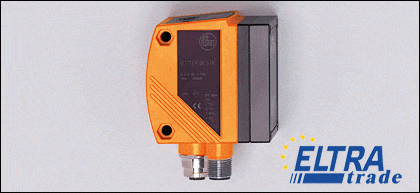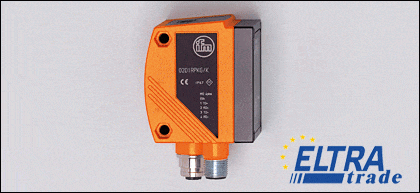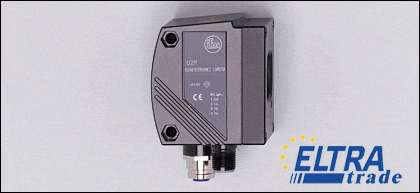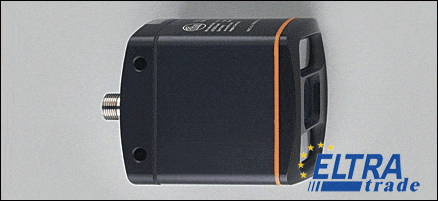IFM Vision sensors
- PMD 3D ToF (Time of Flight) camera for the output of 3D image data
- Device interfaces: digital input/output
- Ethernet
- Angle of aperture 60° x 45° (horizontal x vertical)
- Image resolution 176 x 132 pixels
- Connector, Outputs: max. 2 (configurable)
AFL-12A-ATOM-N270/WT-R/1GB-R20
- MONITOR Analogue Video Input/1 Port
- DC
- 2 m
- M16 Connector
- 2 m
- MONITOR Analogue Video Input/1 Port
- DC
- 2 m
- M16 Connector
- 2 m
MULTIVIEWBOX/4 PORT
Max. field of view size: 640 x 480 mm, Infrared lighting 850 nm, Max. field of view size: 640 x 480 mm, Outputs: max. 5 (configurable) / 24 V PNP
Max. field of view size: 1320 x 945 mm, Infrared lighting 850 nm, Outputs: max. 5 (configurable) / 24 V PNP
Max. field of view size: 400 x 300 mm, Infrared lighting 850 nm, Outputs: max. 5 (configurable) / 24 V PNP
Max. field of view size: 400 x 300 mm, Infrared lighting 850 nm, Outputs: max. 5 (configurable) / 24 V NPN
Max. field of view size: 640 x 480 mm, Infrared lighting 850 nm, Max. field of view size: 640 x 480 mm, Outputs: max. 5 (configurable) / 24 V NPN
Max. field of view size: 1320 x 945 mm, Infrared lighting 850 nm, Outputs: max. 5 (configurable) / 24 V NPN
R360/ETHERNET CAMERA
R360/ETHERNET CAMERA
Max. field of view size: 640 x 480 mm, Illumination: white light, Max. field of view size: 640 x 480 mm, Outputs: max. 5 (configurable) / 24 V PNP
Max. field of view size: 640 x 480 mm, Illumination: white light, Max. field of view size: 640 x 480 mm, Outputs: max. 5 (configurable) / 24 V NPN
Max. field of view size: 1320 x 945 mm, Illumination: white light, Outputs: max. 5 (configurable) / 24 V PNP
Max. field of view size: 1320 x 945 mm, Illumination: white light, Outputs: max. 5 (configurable) / 24 V NPN
Max. field of view size: 400 x 300 mm, Illumination: white light, Outputs: max. 5 (configurable) / 24 V PNP
Max. field of view size: 400 x 300 mm, Illumination: white light, Outputs: max. 5 (configurable) / 24 V NPN
Max. field of view size: 640 x 480 mm, Lighting: infrared (850 nm), Max. field of view size: 640 x 480 mm, Outputs: max. 5 (configurable) / 24 V PNP
Max. field of view size: 640 x 480 mm, Lighting: infrared (850 nm), Max. field of view size: 640 x 480 mm, Outputs: max. 5 (configurable) / 24 V NPN
Max. field of view size: 1320 x 945 mm, Lighting: infrared (850 nm), Outputs: max. 5 (configurable) / 24 V NPN
Max. field of view size: 400 x 300 mm, Lighting: infrared (850 nm), Outputs: max. 5 (configurable) / 24 V PNP
Max. field of view size: 400 x 300 mm, Lighting: infrared (850 nm), Outputs: max. 5 (configurable) / 24 V NPN
PMD 3D sensor, Angle of aperture 40° x 30°, (horizontal x vertical), Connector, Outputs: max. 2 (configurable) / 24 V PNP
PMD 3D camera, Angle of aperture 40° x 30°, (horizontal x vertical), Connector, Outputs: max. 2 (configurable) / 24 V PNP
3D sensor, Device interfaces: digital input/output, Ethernet, Angle of aperture 40° x 30° (horizontal x vertical), Image resolution 176 x 132 pixels, PMD 3D ToF (Time of Flight) sensor for, - Dimensioning of the object: Determination / Comparison of size, position, orientation, measurement quality, - Completeness monitoring, Connector, Outputs: 3 outputs (configurable), 24 V PNP/NPN, acc. to IEC 61131-2
3D camera, PMD 3D ToF (Time of Flight) camera for the output of 3D image data, Device interfaces: digital input/output, Ethernet, Angle of aperture 40° x 30° (horizontal x vertical), Image resolution 176 x 132 pixels, Connector, Outputs: max. 2 (configurable) / 24 V PNP/NPN to IEC 61131-2
IFM O3D302 3D sensor, Device interfaces: digital input/output, Ethernet, Angle of aperture 60° x 45° (horizontal x vertical), Image resolution 176 x 132 pixels, PMD 3D ToF (Time of Flight)
3D camera, PMD 3D ToF (Time of Flight) camera for the output of 3D image data, Device interfaces: digital input/output, Ethernet, Angle of aperture 60° x 45° (horizontal x vertical), Image resolution 176 x 132 pixels, Connector, Outputs: max. 2 (configurable) / 24 V PNP/NPN to IEC 61131-2
In automation technology, vision sensors are an integral part of assembly, manufacturing, and quality control tasks. In a rugged, industrial-compatible package, vision sensors combine lighting, lens, camera chip, evaluation, and process connections for integration into a higher-level controller.
Today we will talk about what IFM industrial imaging is, about the process of industrial visualization, and what devices are needed to implement it.
What is IFM Industrial Imaging?
Industrial visualization is the creation of three-dimensional objects of any scale. Thanks to this technology, it is easy for investors to take a tour of a residential area that will be built only next year, demonstrate the scale of production and technical processes at an exhibition stand or show a new part on an enlarged scale and section, visualize the operation of complex mechanisms and present a new product design.
For industrial imaging, vision sensors for industrial applications are typically used, both in 2D and 3D. Bundled with built-in evaluation in a compact package:
Vision sensors
Stand-alone unit with built-in lighting and evaluation in rugged industrial housing. Electronic eye for availability, completeness, position, quality control, and job sorting.
3D sensors
The 3D sensor can instantly evaluate objects in three dimensions. Each pixel of the matrix of this chip evaluates its distance to the object. The image of the object on the chip matrix and the corresponding distance values correspond to the 3D image. Integrated assessment allows you to assess the state of an object or scene in detail by determining the volume, distance, or level in three dimensions.
3D cameras
The 3D camera instantly identifies scenes and objects in their spatial dimension. Unlike laser scanners, it does not require moving components and is therefore rugged and wear-free. The principle of operation is the same as that of the 3D sensor. In addition to the three-dimensional image of the distance, the camera provides a gray image of the scene. The combination of these images makes it possible to freely program application-specific tasks using a software development kit.
IFM industrial imaging solutions include:
- O2D object recognition sensor with orientation-independent contour checking solves tasks such as presence and position control, quality control, as well as sorting and counting tasks. It is ideal in applications where the shape of the object is repeatable and defined.
- O2B object inspection sensor is used to control the presence, completeness, position, size, and quality, as well as for sorting tasks. It is ideal for applications where objects vary in shape, size, or hue.
- Applications of the O2I multicode reader range from product tracking and product control to product identification. The sensor can read 1D and 2D codes regardless of their position. The 3D camera instantly identifies scenes and objects in their spatial dimension. It measures the distance between the sensor and the nearest surface point by point using the time-of-flight principle.
Applications can be found in packaging, material storage and handling, airport logistics, collision avoidance, robotics, and space and people monitoring.
Luminaires create a uniform light field with visible red or invisible infrared light, either for nearly shadow-free illumination of an object or for highlighting surface features such as dotted lines, scratches, or dents.
The sensor can read 1D and 2D codes regardless of their position. The 3D camera instantly identifies scenes and objects in their spatial dimension. It measures the distance between the sensor and the nearest surface point by point using the time-of-flight principle. Applications can be found in packaging, material storage and handling, airport logistics, collision avoidance, robotics, and space and people monitoring.
Also on the list of IFM industrial imaging products is the 3D Industrial Camera, a unique industrial imaging solution that enables automatic machines to perceive the environment in 3D with human vision.
IFM industrial imaging cameras use a revolutionary PMD time-of-flight sensor that provides a 176 x 132-pixel array for fast and accurate distance measurements up to 23,232 points per field of view.
The distance for each pixel is calculated by comparing the phase shift of the sent and returned infrared light. Each measurement is collected simultaneously and immediately available as a fully calibrated 3D point cloud that can be sent to a PC or controller via Ethernet.
This information can be used to create custom algorithms to solve custom problems. IFM provides developers with a complete SDK for frameworks such as PLC, OpenCV, ROS, and Halcon enabling custom applications in Linux or Windows environments.
Key features of the industrial 3D camera include:
- Light and color-independent PMD technology, at its core, is a measurement method that is not affected by changes in color and lighting in applications.
- Long working range Four powerful infrared LEDs (850nm) are used to illuminate the entire field of view in the 0.3-5m range. Each is protected by scratch-resistant Corning Gorilla Glass.
- Wide field of view The lens defines the field of view. Available in 60° x 45° and 40° x 30° options to suit the application best. The entire lens body is protected by scratch-resistant Corning Gorilla Glass.
- Industrial Image Processing
- Industrial imaging is mainly based on the use of (multiple) special cameras or imaging systems installed on the production line. The second essential component of industrial image processing is a high-performance image processing computer.
Individual cameras are configured for the respective application through various computer interfaces. Industrial imaging accessories include, for example, sensors that drive a camera or camera rails that move cameras.
What is decisive for industrial image processing is not only the resolution as such, expressed in terms of the number of pixels. Also important are pixel size and shape, as well as sensitivity, and frame rate, as well as the ability to control exposure, trigger functions, and the ability of cameras to perform partial scans.
Industrial image processing enables efficient real-time monitoring of products during production. Also at high speeds, industrial image processing is able to guarantee accurate recording. Cameras along the production line can also be placed in places that are inaccessible to people, such as areas with too high/too low temperatures or toxic environments.





























